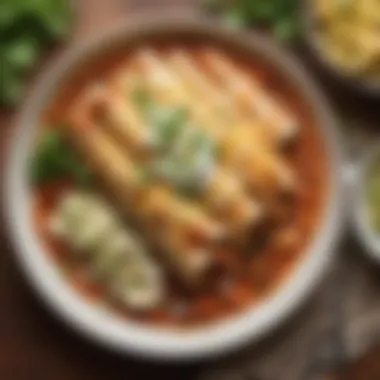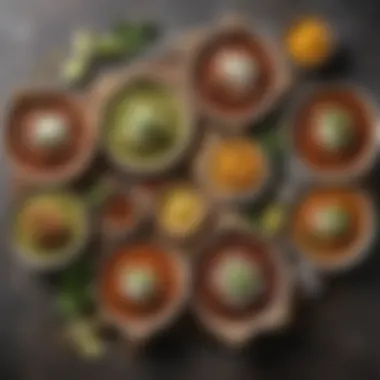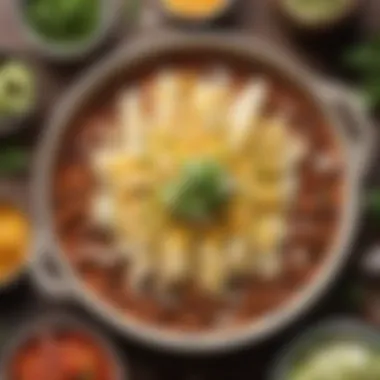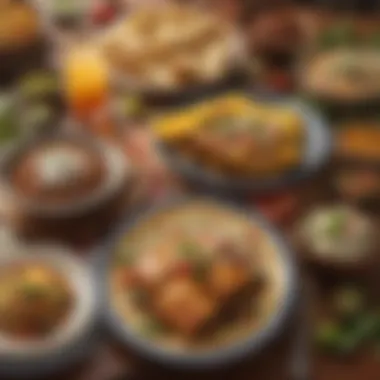Mastering the Art of Mexican Enchiladas


Intro
Enchiladas are a cornerstone of Mexican cuisine, embodying a rich mixture of flavors and tradition. This dish, which originated centuries ago, continues to adapt while serving as a reflection of regional ingredients and cultural significance. In this article, we will provide a comprehensive look at the enchilada, breaking down its complexity into manageable parts for home cooks and enthusiasts alike. Through careful examination of various recipes, ingredient choices, and cooking methods, the reader will gain the ability to craft exquisite enchiladas at home.
In addition to recipes and preparation tips, the article explores the historical background of enchiladas, revealing how they evolved over time into today’s beloved dish. Readers will learn about the different types of sauce, fillings, and methods central to creating an authentic experience. This exploration not only enhances culinary skills but also deepens appreciation for a dish that is central to Mexican heritage.
Preamble to Enchiladas
Enchiladas are more than just a meal; they encompass a rich history and cultural significance within Mexican cuisine. This dish serves as an exploration of flavors and textures. Understanding enchiladas involves recognizing their origins and how they have evolved over time. By diving into enchiladas, we gain insight into Mexican culinary traditions as well as the ingredients and techniques that have shaped them. This section unpacks important aspects of enchiladas, offering a foundation for further exploration.
Historical Background
Enchiladas date back to ancient times, tracing their roots to the Aztec civilization. The Aztecs enjoyed rolled tortillas filled with various ingredients, which closely resembles modern enchiladas. This dish has transformed significantly throughout the centuries. Spanish colonization introduced new ingredients, adding depth to the flavors of enchiladas. For instance, the incorporation of cheese, meats, and an array of spices enhanced the original recipe, leading to the diverse creations we see today.
As time progressed, enchiladas became a staple in Mexican households. Regional differences began to emerge, with each area crafting distinct variations. Northern Mexico often features flour tortillas, while corn tortillas are predominant in the south. This evolution reflects the geographic and cultural influences on the dish, showcasing how enchiladas have been adapted across regions.
Cultural Significance
Enchiladas hold a special place in Mexican culture. They are not only a culinary delight but also a dish that fosters community. Often served at family gatherings and celebrations, they symbolize togetherness and sharing. The act of preparing enchiladas can be a communal experience, where families come together to roll tortillas and fill them with their favorite ingredients.
Moreover, enchiladas represent a connection to Mexican heritage. Recipes are often passed down through generations, preserving traditional techniques and flavors. This process reflects a broader narrative about food as a form of cultural expression. In essence, enchiladas are more than just food; they encapsulate history, identity, and a sense of belonging.
"Food is our common ground, a universal experience."
Core Ingredients of Enchiladas
Understanding the core ingredients used in enchiladas is essential to mastering this iconic Mexican dish. The right components not only define the flavor and texture of the enchiladas but also contribute significantly to their cultural and regional identity. Each ingredient plays a distinct role, creating a harmonious concoction that resonates with tradition while allowing room for innovation. In this section, we will explore the essential components and the various filling options available, focusing on meats, vegetables, and cheeses.
Essential Components
The foundation of any good enchilada lies in its core ingredients. Generally, a basic enchilada requires corn tortillas, filling, sauce, and garnishes.
- Corn Tortillas: Made from masa harina, which is finely ground corn, these tortillas hold the enchiladas together. Their authenticity, flexibility, and flavor are unmatched by any substitute.
- Filling: This can vary widely depending on personal preference and regional variations. Choosing the right filling is critical as it significantly influences the overall taste experience.
- Sauce: The sauce is perhaps the most crucial element. A well-crafted enchilada sauce will enhance and complete the dish. It should complement the fillings while adding a depth of flavor.
- Garnishes: Toppings like cheddar cheese, crema, or fresh cilantro give a final touch that elevates the dish.
Considering these components is essential for anyone looking to create an authentic enchilada experience.
Variations in Fillings
Meats
Meat fillings have a vital role in enchilada preparation. They provide a rich flavor and protein source that many find satisfying. Common choices include shredded chicken, beef, or pork, each bringing its own unique characteristics.
- Shredded Chicken: Popular for its subtle taste and ability to absorb flavors from the sauce.
- Ground Beef: Provides a hearty texture, making it very common in many homes.
- Carnitas (Shredded Pork): Known for its juicy and flavorful profile, often contributing a more complex taste.
Meats are a popular choice in traditional recipes, making the dish hearty. However, this ingredient can also be high in calories, which might be a consideration for health-conscious eaters.
Vegetables
Using vegetables as filling caters to those preferring lighter options. They are fresh and vibrant, adding essential nutrients and flavors to enchiladas.
- Common Choices: Spinach, zucchini, and bell peppers are frequently used in possibly healthier enchilada varieties.
- Nutritional Benefits: Vegetables offer fiber and minerals, and help balance out richer flavors usually present in enchiladas.
While vegetables may not always provide the heft of meat, they are a versatile filling that can adapt to whatever sauces or spices are incorporated.
Cheeses
Cheeses are essential to the texture and richness of the dish. A variety like Cotija, queso fresco, or Monterey Jack can be utilized to melt or crumble over enchiladas.


- Cotija: This cheese adds a salty, crumbly texture that enhances the overall flavor without overpowering other ingredients.
- Monterey Jack: Known for being mild and creamy, it melts smoothly into the dish, enriching the experience.
Cheeses serve to tie the flavors together while offering an indulgent comfort component. However, one must be mindful of the fat content in cheeses and adjust their choices accordingly for healthier options.
Types of Sauces
The type of sauce used in enchiladas plays a vital role in determining the overall flavor and character of the dish. Sauces are not merely an accessory; they are a fundamental component that enhances the taste and unifies the different ingredients. Choosing the right sauce can elevate a simple enchilada into a profound culinary experience. It is beneficial to understand the different sauces available, as they can influence not just the flavor but also the texture and appearance of the enchiladas.
Red Sauce
Red sauce, known as salsa roja, is one of the most traditional options for enchiladas. This sauce typically consists of tomatoes, dried chilies, garlic, and various spices blended to create a rich, flavorful mixture. The preparation starts with rehydrating dried chilies like ancho or guajillo, which contribute a warm, smoky flavor. Once the chilies are softened, they are blended with tomatoes and additional ingredients until smooth. The choice of chili can affect the heat level. Adding onions or spices like cumin can further enhance the flavor profile.
Using red sauce brings a vibrant color to enchiladas and pairs well with various fillings, including meats and cheeses.
Green Sauce
Green sauce, or salsa verde, is another highly popular alternative. This sauce is made primarily from tomatillos, which have a tart flavor that sets it apart from red sauce. The tomatillos are usually roasted or boiled and then blended with ingredients such as green chilies, cilantro, lime juice, and sometimes garlic. The result is a sauce that is fresh and zesty.
This bright green sauce offers a lighter option for enchiladas and works exceptionally well with lighter fillings such as chicken or vegetables.
Creamy Sauces
Creamy sauces are a more modern approach to enchiladas, introducing a rich and indulgent element. These sauces often start with a base of sour cream or crema mixed with green chilies or herbs to add flavor. One common variation includes adding cheese into the sauce, creating a beautiful creamy texture.
Creamy sauces can provide a nice contrast to savory fillings, making the dish feel more decadent. It is important to balance these sauces properly, as they can easily overwhelm the other ingredients if used too liberally.
Using the right sauce can turn a good enchilada into a great one, enriching the flavors and enhancing the overall experience.
Each sauce brings its character and flavor profile, allowing for a diverse range of enchilada options. Understanding these sauces not only empowers cooks to make informed choices but also invites personal creativity in the kitchen.
Traditional Enchiladas Recipe
The Traditional Enchiladas Recipe holds a significant place within the broader exploration of Mexican cuisine. They encapsulate not just the flavors but also the cultural heritage of Mexico. Through this section, we highlight essential elements, benefits, and considerations that make this dish a staple in many households.
The process of creating traditional enchiladas is both an art and a science. It involves selecting the right ingredients, mastering preparation techniques, and understanding the cultural context of the dish. The simplicity of the recipe belies the depth of its flavors and the enjoyment it brings to the table.
Ingredients List
To prepare traditional enchiladas, the choice of ingredients plays a crucial role. Below is a list of essential ingredients:
- Corn tortillas: The base of enchiladas, these should be soft and pliable.
- Protein: Options include shredded chicken, beef, or cheese for a vegetarian option.
- Enchilada sauce: Typically red or green, made with Chile peppers, tomatoes, and seasonings.
- Cheese: Queso fresco or shredded cheese, such as Monterey Jack or Cheddar.
- Onions: Sautéed onions add sweetness and depth.
- Cilantro: Fresh cilantro for garnish, adding a fresh note.
- Sour cream: Optional, for serving.
Step-by-Step Preparation
- Prepare the Sauce: Begin by cooking your choice of sauce. For red sauce, blend tomatoes, guajillo chilies, garlic, and spices. For a green sauce, use tomatillos, green chilies, and cilantro.
- Cook the Filling: If using meat, it should be cooked and shredded. For vegetarian options, choose sautéed vegetables or beans.
- Prepare the Tortillas: Lightly heat the tortillas to make them easier to roll without tearing.
- Fill the Tortillas: Place a spoonful of the filling on each tortilla. Roll them tightly and place seam-side down in a baking dish.
- Top with Sauce: Pour the sauce generously over the rolled tortillas.
- Add Cheese: Sprinkle cheese evenly on top.
- Bake: Place in the oven at 350°F for about 20 minutes, or until the cheese is bubbly and golden.
Serving Suggestions
When serving traditional enchiladas, presentation can enhance the dining experience. Here are some ideas:
- Garnish: Top with fresh cilantro or chopped onions.
- Accompaniments: Serve with a side of Mexican rice and refried beans for a complete meal.
- Beverage Pairings: Consider pairing with a light Mexican lager or even a fruity red wine to complement the flavors.
"Enchiladas are a canvas where you can express creativity with fillings and sauces while respecting tradition."
By adhering to these guidelines, one can create authentic traditional enchiladas that resonate with the cultural significance of this beloved dish.
Modern Variations of Enchiladas


Modern variations of enchiladas reflect a shift in culinary practices and consumer preferences. As traditional recipes meet contemporary tastes, chefs and home cooks alike explore new ways to interpret this classic dish. By integrating alternative ingredients and cooking methods, these modern enchiladas maintain the essence of their origins while catering to a diverse audience. This section highlights the importance of adapting traditional recipes to promote inclusivity, ensuring that everyone can enjoy enchiladas regardless of dietary restrictions.
Vegetarian Enchiladas
Vegetarian enchiladas have gained popularity as more people embrace plant-based diets. These dishes often feature fillings such as black beans, zucchini, bell peppers, and corn, providing a satisfying and nutritious option without meat. The flavor profiles are enhanced by combinations of spices and sauces, such as tomatillo or roasted pepper, that bring depth to the dish.
In order to prepare vegetarian enchiladas, start by sautéing your preferred vegetables until tender. Mix them with fresh herbs and spices for added depth. Then, fill corn tortillas with the mixture, rolling them tightly before placing them in a baking dish. Pour your chosen sauce over the top and sprinkle with cheese or a vegan alternative before baking. This variation appeals to both vegetarians and those simply looking to reduce their meat consumption, offering an array of colorful and delicious options.
Gluten-Free Options
Gluten-free enchiladas are essential for accommodating individuals with gluten sensitivities or celiac disease. Traditional corn tortillas are naturally gluten-free, making them a suitable base for these dishes. However, it is crucial to check for cross-contamination when purchasing tortillas.
To prepare gluten-free enchiladas, focus on using quality corn tortillas and fillings that do not contain gluten. Popular fillings include seasoned shredded chicken, sautéed vegetables, or beans combined with rice. Once filled, roll the tortillas and place them in a baking dish. A gluten-free sauce, like a homemade red sauce verifying ingredients, or a green sauce made fresh, can elevate the dish further.
Offering gluten-free options ensures that enchiladas can be enjoyed by a wider audience without compromising on taste and authenticity.
Fusion Enchiladas
Fusion enchiladas represent the creative intersection of culinary traditions, where you might find influences from other cuisines melding with classic Mexican elements. The key to successful fusion enchiladas lies in respecting the original flavors while introducing new ingredients or techniques.
For example, one might consider adding ingredients such as kimchi or pulled pork, inspired by Korean cooking. Alternatively, Mediterranean ingredients like feta cheese and olives can create a unique flavor profile. It is possible to experiment with sauces such as a chipotle-infused tzatziki, bridging culinary cultures within the dish.
When crafting fusion enchiladas, visualize based on complementary flavors. This endeavor takes tradition and gives it a modern twist, allowing for endless experimentation in the kitchen. In doing so, these enchiladas entice food lovers who might be seeking novel culinary experiences while still honoring the heart of Mexican cuisine.
Nutritional Considerations
Understanding the nutritional aspects of enchiladas is vital for anyone looking to enjoy this traditional dish while maintaining a balanced diet. Enchiladas can be tailored in many ways to accommodate different dietary requirements and preferences. This section will discuss two main components: caloric content and dietary benefits.
Caloric Content
The caloric content of enchiladas varies significantly based on the ingredients used and the size of the portion. A typical serving of a cheese enchilada, for instance, contains around 300 to 400 calories. When meat or more elaborate sauces are added, the total can increase substantially. It is important to consider these aspects, especially for individuals monitoring their caloric intake.
- Calories in Different Types of Enchiladas:
- Cheese Enchiladas: 300-400 kcal
- Chicken Enchiladas: 350-450 kcal
- Beef Enchiladas: 400-500 kcal
- Vegetarian Enchiladas: 250-350 kcal
Pay attention to portion sizes as well. Often, people underestimate how much they consume. This oversight can lead to exceeding daily caloric needs.
Dietary Benefits
Enchiladas can provide various nutrients, depending on their filling and toppings. Here are some nutritional benefits:
- Protein Sources:
- Vitamins and Minerals:
- Healthy Fats:
- Whole Grains:
- If made with chicken, beef, or beans, enchiladas are a good source of protein, essential for muscle repair and growth.
- Enchiladas that include vegetables such as bell peppers, onions, and spinach contribute vitamins A and C, along with dietary fiber that aids in digestion.
- When using avocado or moderate amounts of cheese, enchiladas can provide healthy fats, which are beneficial for heart health.
- Opting for corn tortillas adds whole grains to your meal, which can help with satiety and provide additional fiber.
Enchiladas can be a balanced meal when prepared with an emphasis on nutrition, providing essential nutrients without compromising on flavor.
Conclusion on Nutritional Considerations:
By being mindful of the ingredients and preparation methods, enchiladas can serve as a nutritious option within a well-rounded diet. Deep awareness of caloric intake and dietary benefits allows one to enjoy this dish responsibly.
Common Mistakes to Avoid


Cooking enchiladas can seem straightforward, but several common mistakes can detract from the overall experience. Understanding these errors ensures the dish not only tastes good but also represents its authentic roots. Avoiding such pitfalls allows both novices and experts to engage better with this iconic recipe.
Overstuffing Enchiladas
One of the most frequent mistakes when preparing enchiladas is overstuffing them. It may seem tempting to pack in as much filling as possible, but this leads to several issues. Firstly, overstuffed enchiladas tend to break apart during the rolling process, resulting in a messy presentation. Furthermore, too much filling can overwhelm the dish's balance of flavors.
A good rule of thumb is to use about two to three tablespoons of filling per tortilla. This amount strikes a balance between enjoying the filling and maintaining the integrity of the enchilada. When rolling them, ensure that the filling is evenly spread and leaves enough space to fold the tortilla securely without tearing.
Ignoring Sauce Balance
Another common error is neglecting the sauce's role in the overall flavor of the enchiladas. The sauce should complement rather than overpower the filling. Using either too little or too much sauce can lead to bland or soggy results. Ideally, the sauce should enhance the flavors while still allowing the other ingredients to shine.
For a well-balanced flavor, consider the following:
- Layering sauce: Apply a thin layer of sauce at the bottom of the baking dish before placing the rolled enchiladas. This prevents sticking and infuses the tortillas with flavor.
- Coating appropriately: After assembling the enchiladas, a light drizzle of sauce over the top is sufficient. This keeps the tortillas from drying out while ensuring the flavors remain balanced.
- Adjusting spice levels: It is also vital to taste the sauce as you prepare it. This allows you to adjust spice levels or acidity as needed, ensuring that it works in harmony with the other components.
Tackling these mistakes can transform your enchilada experience, enhancing both taste and the joy of cooking.
Pairing Enchiladas with Beverages
When enjoying enchiladas, the choice of beverage plays a crucial role in enhancing the overall dining experience. The right drink not only complements the dish but also elevates its flavors, making each bite more enjoyable. Understanding how to pair enchiladas with beverages involves considering elements such as the sauce used, the filling, and personal taste preferences.
Choosing beverages that balance the rich flavors of enchiladas can enhance your meal. The spiciness of the sauce, the richness of the cheese, and the heartiness of the fillings can all influence what to drink. Proper pairing can create a harmonious taste experience, ensuring that neither the food nor the drink overpowers the other.
Mexican Beers
Mexican beers are a natural choice for pairing with enchiladas. Their light and refreshing qualities can help counterbalance the heaviness of the dish. Popular options include:
- Corona: Its crisp flavor makes it a classic match for various enchilada types.
- Modelo Especial: A slightly richer beer, it offers a fuller taste that complements beef or cheese-filled enchiladas.
- Pacifico: This is another light beer that pairs well, especially with chicken enchiladas and tomatillo sauce.
The carbonation in beer can also cleanse the palate between bites, making each taste as vibrant as possible.
Wine Alternatives
For those preferring wine, several selections can work well with enchiladas. The choice of wine often depends on the specific ingredients in the dish:
- Sauvignon Blanc: Its crispness and acidity work great with lighter enchiladas, like those filled with vegetables or chicken in a green sauce.
- Tempranillo: This red wine complements red sauce enchiladas, as its fruity and earthy notes mirror the richness of the dish.
- Rosé: A versatile option, it can balance both meat and vegetarian enchiladas, enhancing the overall flavor without overshadowing the meal.
When selecting a wine, consider serving it slightly chilled to refresh the palate and balance the spices.
Pairing beverages skillfully can transform a meal into an experience, enhancing the flavors of both the food and drink.
Epilogue
In concluding this comprehensive article on enchiladas, it is essential to realize this dish's enduring relevance in both culinary practices and cultural traditions. Enchiladas are more than mere food; they symbolize the rich heritage of Mexican cuisine. Understanding the intricacies involved in creating enchiladas enhances not only the cooking experience but also appreciation for the diverse flavors and techniques involved.
Summary of Key Points
As we have explored, the making of enchiladas is layered with both complexity and simplicity. Key points from this article include:
- Historical Context: A glimpse into how enchiladas evolved and their cultural bearings.
- Core Ingredients: Identification of essential and varied components that contribute to the distinctive flavors.
- Sauce Varieties: Understanding the importance of different sauces like red, green, and creamy options.
- Cooking Techniques: Emphasis on the processes involved in preparing traditional and modern variations of enchiladas.
- Nutritional Aspects: Discussion on caloric values and potential dietary advantages.
- Common Pitfalls: Guidance on mistakes often made during preparation, helping to ensure successful outcomes.
- Pairing Suggestions: Options for beverages that harmonize well with enchiladas, enhancing the dining experience.
These key points not only inform cooking practices but also illustrate the dish's cultural significance in Mexico and beyond.
Encouragement to Experiment
Culinary exploration is an essential journey for any food enthusiast. With enchiladas, there is a wide array of ingredients, sauces, and preparation methods to explore. Encouraging experimentation can lead to personal discoveries in flavor combinations and techniques. Consider trying unique fillings like roasted peppers or diverse cheeses, or perhaps altering traditional sauces for modern twists.
Each attempt at crafting enchiladas can serve as a canvas for personal creativity. Therefore, whether sticking to classic recipes or venturing into uncharted territory, embrace the process.
"Cooking isn't just about recipes; it's an expression of creativity and culture."
Remember, the true joy of food lies in exploration and personal preference. Enjoy the process, and let your curiosities guide you as you strive to master the art of enchiladas.







